A well-designed chicken coop and run will keep your chickens safe and allow you to care for them more easily. Here are fifteen design features that you will love to have in a chicken coop, from fencing to nesting boxes. Portability, cleanliness, and ease of use are all factors that impacted our decision to design the best chicken coop possible.
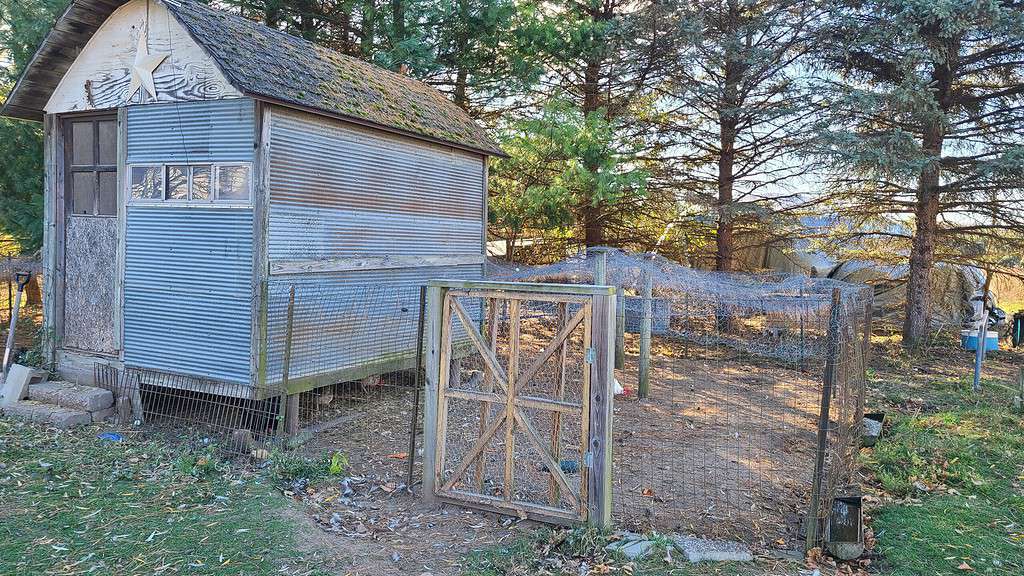
This post contains affiliate links. As an Amazon Associate, I earn from qualifying purchases.
Maybe you are doing some research before you start building the chicken coop of your dreams, or maybe you already have one, but it needs an overhaul. Whatever the case, you have come to the right place for ideas!
I have been raising chickens for decades and inherited a coop that my dad made over 30 years ago. It has some outstanding features that he incorporated and a few I have added over the years.
We have a flock of around 30 dual-purpose hens and 1-2 roosters. Currently we have breeds including Ameraucana, Australorp, Rhode Island Red, Plymouth Blue, Barred Rock, Leghorn, Silver-laced Wyandotte, Black Sex Link, and Korean Ogye. They wake us up in the morning, entertain us, give us colorful, delicious eggs, and my kids show them at the county fair.
We allow our chickens to free-range when the weather is decent from morning chores until dark, then we close them in. Even though they don’t use their coop or run 24-7, having it accessible and equipped is absolutely necessary.
On our farm first and foremost comes animal health and safety, next functionality, and last aesthetics. In other words, what we have works, but it might not be the prettiest!
1. Sturdy Fencing for the Chicken Run
We opted for 4-foot-tall welded wire “garden fence” instead of the traditional “chicken wire” type fencing for our run. The welded wire is much sturdier and we feel more predator proof. It is also easier to connect to the T-posts since there is a straight seam to line up.
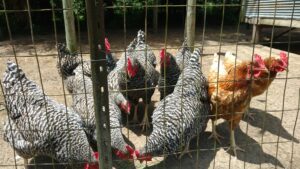
2. A Roof for the Chicken Run
We went several years with an “open air” chicken run and did OK. There were causalities, however. Without a top on the chicken run there was nothing to stop hawks from swooping in during the day or raccoons from scaling the fence at night. To protect our flock, we decided to use traditional chicken wire as a roof. To support the roof in the middle of the pen we put in a few wooden fence posts with 6 inch square cut pieces of plywood to distribute the weight (see picture below).
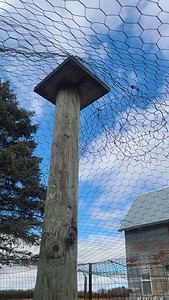
3. Water Outside of the Chicken Run Fence
This feature has benefits for both the chickens and the farmer. It benefits the chickens because they can still easily get to the water and drink by sticking their heads through the fence, but it stays clean longer because it doesn’t get contaminated with poop or dust. The benefits for the farmer are that it is easy to get to and you can fill the water without worrying about letting any chickens out if you want to keep them in.
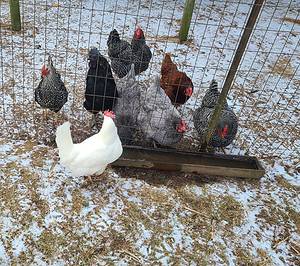
4. A Gate to the Chicken Run
There are several reasons why you might need to get inside your chicken run and that’s when a gate comes in handy. We use the gate to let the chickens in and out. We also open the gate to throw table scraps into the run for the chickens to eat. If you need to catch a chicken and medicate it, you will need to get inside too. We framed our gate with 2x4s and then covered it with chicken wire. See our gate in the image at the top of this post.
5. Skids for Moving the Chicken Coop
Maybe the spot you initially chose isn’t ideal, you want to give your birds a fresh area to scratch, or a change of scenery- whatever the reason, it is nice to have the option to move your chicken coop. My dad was a pipefitter so he made our chicken coop with pipe skids. We use the tractor to relocate the coop when we want to and just put the fence back up around it.
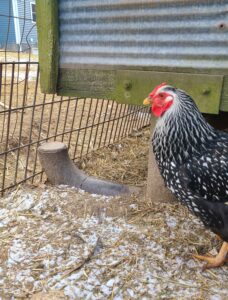
6. Windows in the Chicken Coop
Having a window or two in your chicken coop can help your chickens stay laying for a longer period of time in the winter, when hours of daylight are limited. My coop doesn’t have electricity, so having windows allows me to see in there without a flashlight or head lamp which is nice! Windows that open and shut are ideal because they can help with ventilation in the summer months. The one I have in the front of my coop is an old truck back window and the sliding feature is great because I can close it around an electrical cord if needed.
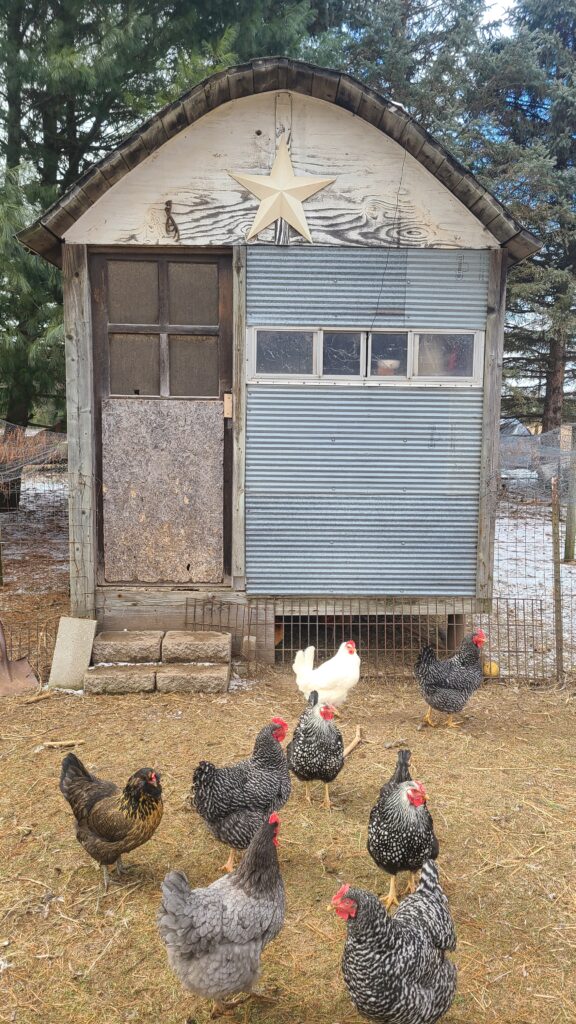
7. Raised, Grate Floor for the Chicken Coop
I love this chicken coop feature and I am so glad I have it. The raised, grate floor allows for poop to fall through into the dirt below the coop so that it doesn’t build up. When the chickens are below the coop they scratch around and spread it out. Not only that, but the grate allows for ventilation of the coop as well. It is easy to clean the floor with a flat-nosed shovel when you need to. I know some people may worry about their chicken’s toes getting caught or it being uncomfortable for them, but I have not had any issues.

8. Ramp for Chicken Coop
If you have the raised, grate floor that I mentioned above you will need some way for your chickens to get into and out of their coop. I have a little ramp for my birds that they learn to use very quickly. We put some cleats on this ramp so the birds get better traction. You can make it hinged if you want so you can secure the coop at night.
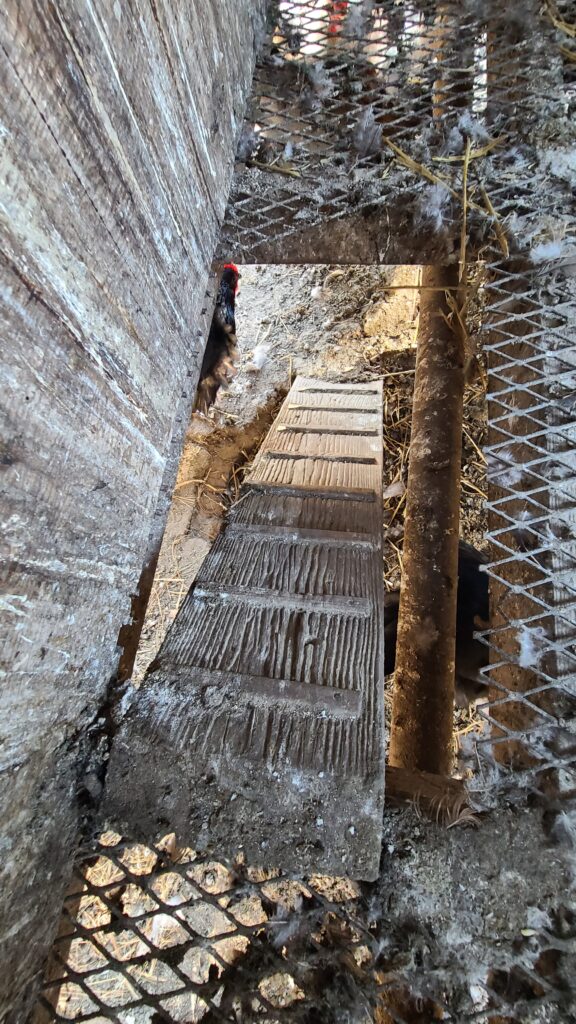
9. Roosting Perches for Chicken Coop
Inside the coop, there are a few necessary features you need to make sure to have including roosting perches. You want to have enough space so that all of your birds can get off the ground to sleep. We have used natural wood from branches (see bottom rung in picture), old hoe handles (see middle rung in picture), and scrap wood (side rungs in picture). Anything made of wood, circular in shape, and with a diameter of about 2 inches will work just fine.
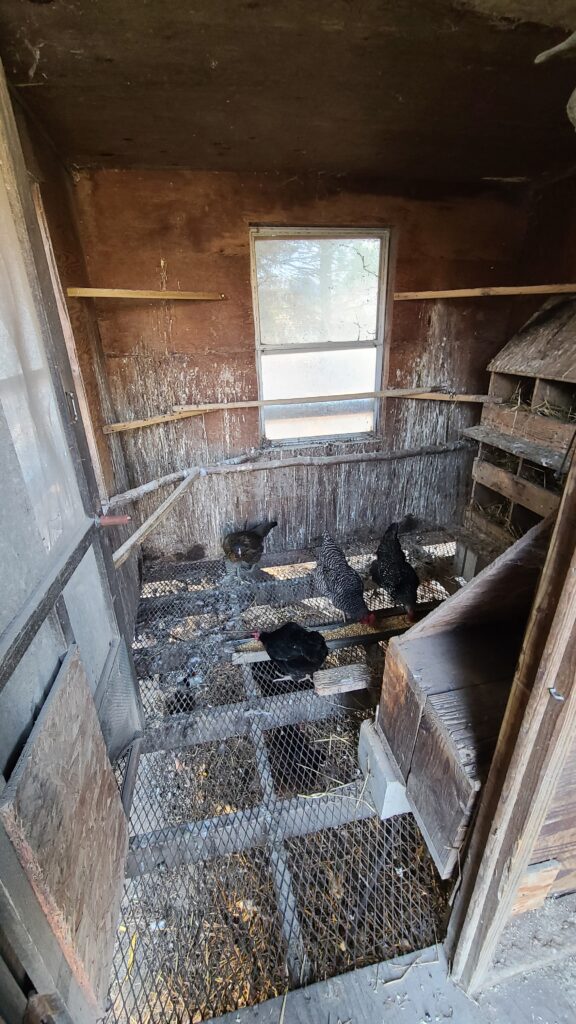
10. Laying Boxes for the Coop
If you have hens you will want to provide them with a safe, comfortable place to lay their eggs. Most of my free-ranging hens return to the coop to lay and then venture back out afterward. Sometimes we find a cache of eggs in a hiding spot in the yard, but not that often because they prefer to lay in a secure area. The ideal size for a laying box is around 1 cubic foot for a standard-sized (non-bantam) hen. Having one laying box for every 4 hens should be plenty. I have found that there are a few “favorite” laying boxes that hens will wait to use even if there are other ones available! Be sure to keep the laying boxes clean, your hens may go find a different spot if they feel what you provide is unhygienic. Straw, hay, or pine shavings are all suitable bedding materials for inside the laying boxes.

11. Feeder in the Coop
I have a feeder in my coop because then I don’t have to worry about the weather and the layer mash getting rained on or snow in it. I have a long, tray-type feeder, which I like because there is room for quite a few of my birds to feed at the same time, but there are other, better feeder options for keeping your chicken feed from getting contaminated.
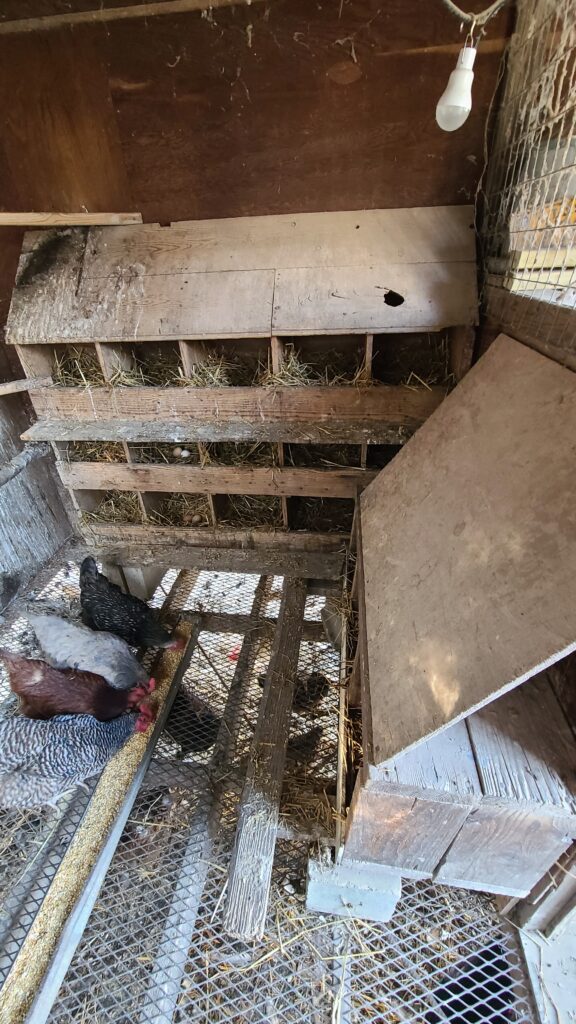
13. Solar Light for the Coop
I live in Michigan and to deal with the limited hours of daylight in the winter months, (although I do have windows in my coop) I use a solar light. I hang the light in my coop and turn it on when I do evening chores. The light is fairly weak, doesn’t stay on for more than a few hours, and does not get hot– so it is not a fire hazard. I consider this a supplement to the natural sunlight for my birds in the winter, not a replacement. If you are interested in actually making up for loss of daylight I would use an LED with higher output and have it on a timer.
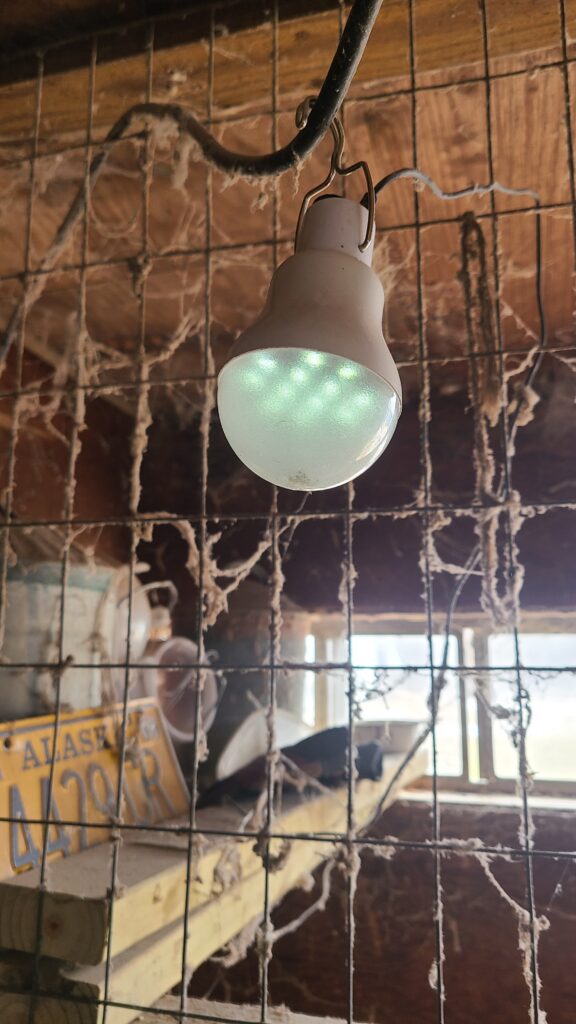
14. Food Storage Area in Coop
My coop has double doors, inside the first door is the storage area where I keep their food and my supplies. The second door is used to enter the coop area where the birds are. Having a separate “room” for the food and supplies helps ensure that these items stay clean. I keep my chicken feed in a plastic barrel. You want to store feed in a container that is rodent-proof with a secure lid. Keep a scoop handy for feeding time- I use an old can.
For more ideas on how to store feed, click here to read my other article!
14. General Storage Area in the Coop
Along with chicken feed, I keep other random items I may need at chore time in the storage “room” in my coop. You might find buckets, feeders, waterers, heat lamps and bulbs, shovels, egg cartons, among other things in this area. A shelf in a chicken coop is a good idea!
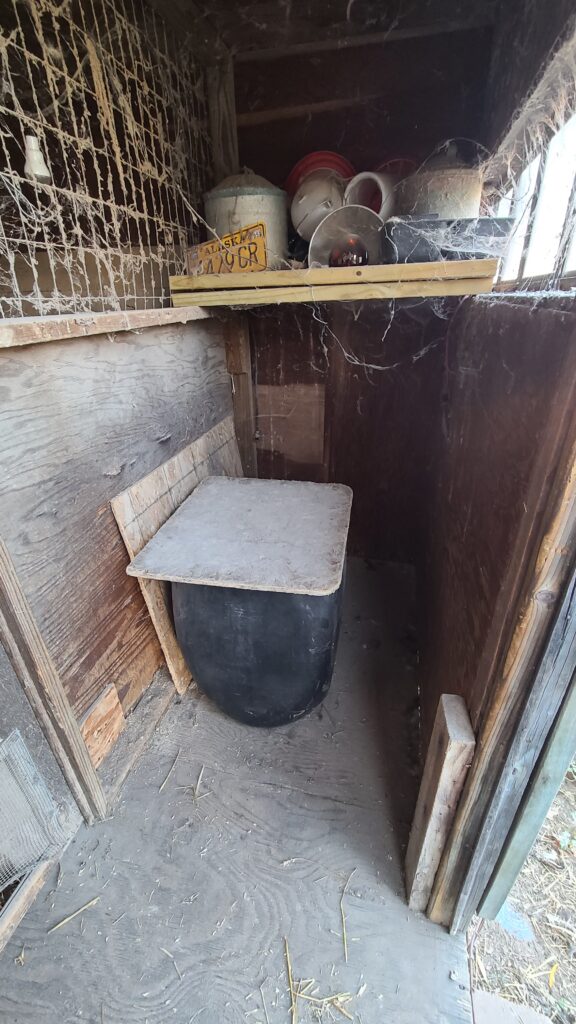
15. Brooder Box Area in the Coop
The nice thing about my coop is that I can convert my storage room into a brooder box if I have chicks. I keep a piece of OSB, cut to size, in the storage room and screw it between the first two walls to enclose the area (I do have to put the feed somewhere else temporarily). I then affix a heat lamp and run an extension cord to it, through the window. The chicks are able to grow, protected from the elements and predators until they are big enough to be incorporated into the rest of the flock.
For more information on setting up a brooder for chicks, click here to read my other article!
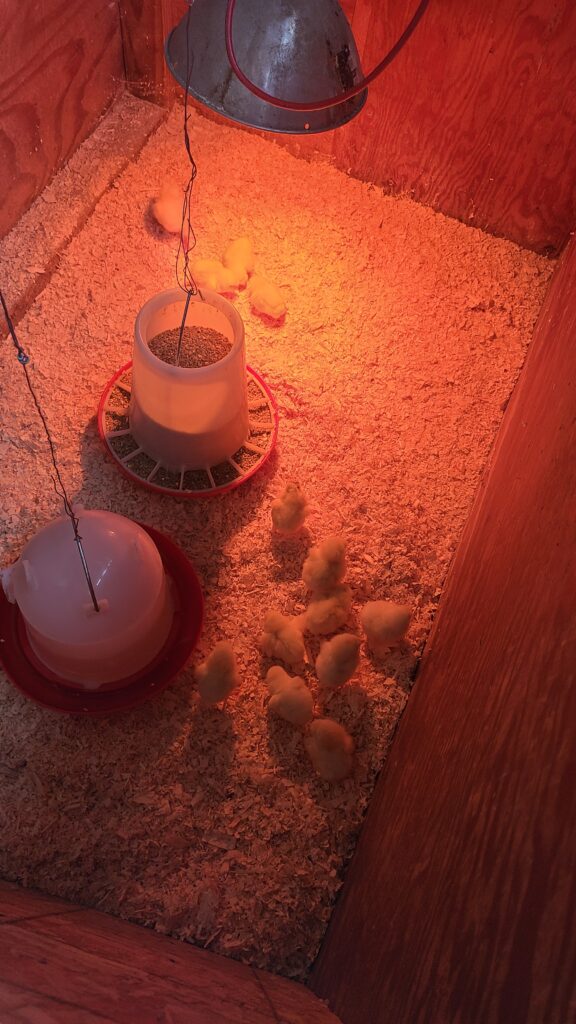
Is there a feature in your chicken coop or run that didn’t make our list? Tell us about it in the comments below!

Mother, farmer, author, and teacher by trade… She loves tending to things and watching them grow!
